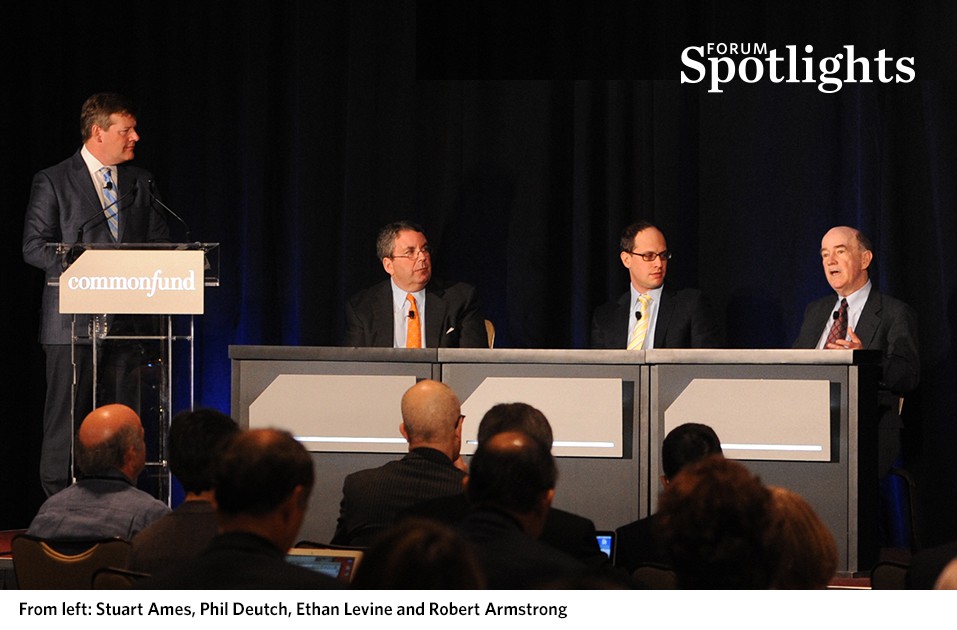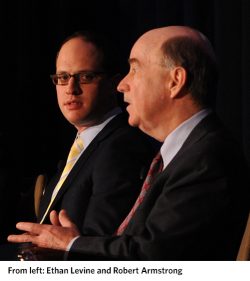Advances in alternative energy technologies promise to reduce the world’s dependence on fossil fuels. Largely, however, they remain just that—a promise. So, where are the opportunities to invest in the evolving energy environment?
At Commonfund Forum 2016, a panel discussion took on this question. Excerpts from the exchange follow. The discussion was moderated by Commonfund Managing Director, Strategic Solutions, Stuart Ames. The panelists were: Robert Armstrong, Director, MIT Energy Initiative and Chevron Professor of Chemical Engineering, MIT Sloan School; Phil Deutch, Managing Partner, NGP Energy Technology Partners; and Ethan Levine, Director, Commonfund Capital.

INTRODUCTION
Stuart Ames: Yesterday, one of our panelists said, “You know, we’re not going to need oil in 20 years, except for airplanes.” I Thought, “What … no oil in 20 years?” Estimates are that fossil fuels power about 80 percent of our energy usage. Aircraft only account for a small piece of this amount – about 2 percent. If that manager is right, the implication is that over the next 20 years we’re going to transform power generation for the remaining 78 percent. As an investor, I think there must be some ideas here, so we’re going to talk today about how we may be able to make some money in next generation energy.
BEYOND OIL AND GAS: EMERGING ENERGY INVESTMENTS
Ames: When we think about all of the alternative energy investments that were made in the 1970s, ‘80s and ‘90s it seems as though we haven’t had any brand name successes while there have been disappointments. What’s changing?
Ethan Levine: At Commonfund, we think in terms of two buckets: first, clean energy, which encompasses infrastructure like renewable solar and wind and, second, what we call clean tech. We have a handful of portfolio companies in each of those buckets. Success has been mixed across each bucket.
Phil Deutch: If you look at public companies such as First Solar or Sun Power, these are multi-billion dollar, hugely cash flow positive companies in what I call “energy technology.” Energy is roughly 8 percent of GDP. Apply all the technology coming out of places like MIT, Cal Tech or Stanford to the energy industry, and you have a significant area of the economy that’s going to experience the same type of disruption that we have seen in others. That’s what has changed. So many parts of our economy have been disrupted by technology, I truly believe that it’s now time for energy. If anyone disagrees, they’ll have to explain to me why technology won’t work here when it has worked in so many others.
Robert Armstrong: I think it will work, and, in fact, if you go back to the question about the’70s and ‘80s, what did we do that made an impact? Solar for one—that’s when it got going with silicon research. Silicon is now 20 percent-plus efficient. The battery technology in your cell phones and other consumer products started in the ‘70s. Actually, it began with an effort to figure out how to electrify transportation. It was lithium battery technology that ended up not being safe, but with more research it morphed into today’s lithium-ion technology.
Deutch: In the U.S., 50 percent of all solar installations have been done in the last three years. The growth curves on wind power are stunning. Alternatives are still a small part of the energy infrastructure and there are risks—it’s capital intensive and there’s regulatory risk. But that’s true elsewhere. Uber faces those problems as does Airbnb. Yet they’re managing to make it happen.
Levine: There’s a lot of disruption that could occur in the energy space. But, the question for venture investors is where to achieve the best risk-adjusted returns – a capital-efficient industry like IT or a more capital-intensive industry like energy. Investors tend to favor capital efficiency.
 Deutch: Good point, but our investment philosophy is to go for singles and doubles and advance runners around the bases. That’s the prudent way to approach energy technology. The people who have made money for investors have had a vision, but they’ve not forgotten fundamental valuation approaches, incentives and alignment.
Deutch: Good point, but our investment philosophy is to go for singles and doubles and advance runners around the bases. That’s the prudent way to approach energy technology. The people who have made money for investors have had a vision, but they’ve not forgotten fundamental valuation approaches, incentives and alignment.
Armstrong: There’s opportunity in technologies that can make existing power systems more energy efficient and environmentally responsible. For example, 85 percent of the world’s power plants use a thermal process for making the steam that powers electrical generators. At the back end is a condenser to convert the steam back to water before recycling it back into the process. There’s new technology coming out of modern material science that coats the condenser in a way that makes heat transfer seven times better. It is just now coming out as a new start-up company. This is an example of new technology that can make today’s systems much more efficient. If you can improve efficiency a couple of percentage points, it could have a huge impact on both our energy resources and greenhouse gas emissions.
CAPITAL REQUIREMENTS
Ames: One of the challenges facing energy companies is high capital requirements. How do we overcome that challenge to make these companies viable long-term investments?
Armstrong: The challenge is to find the sweet spots where, at least early on, you can work within existing systems. In today’s solar market, the sensitive price point is in so-called balance of systems, which includes non-module component cost, installation cost, permitting cost and such. We are beginning to see innovations that optimize balance of systems and lower costs; that can have a big impact and could potentially be quite profitable.
Deutch: When you invest in energy technology companies, they never fail because of technology or a lack of capital. We don’t make bets on technologies that just don’t work. That’s better left to government or research universities. Too much capital is really a business model question. To me, it’s not the capital intensity that’s the problem. It’s the discipline with which capital is being used.
Armstrong: I think an interesting example is in the area of solar where the two big competitors are photovoltaics, which is very modular and can be done on a small scale, versus the so-called concentrated solar power, where mirrors are used to focus sunlight on a heat transfer fluid used to run a thermal power plant. The difference between those two in terms of capital requirements is striking. If you want to get into the concentrated solar power business, you need at least $1 billion whereas photovoltaics allow you to go small scale and learn by doing a gradual scale-up.

—Ethan Levine
STORAGE CHALLENGES
Ames: Let’s talk a little more about the storage problem. We all see this as a challenge to energy sources that can be intermittent, like solar and wind.
 Armstrong: There are two other issues with storage in general and solar in particular that we have found in modeling the electricity system in the U.S. One, as solar penetration increases, the value to an owner of a solar generation facility decreases unless there is storage. The issue is the more solar there is online at midday at zero marginal cost, the lower the value of that electricity to everybody who is producing at midday.
Armstrong: There are two other issues with storage in general and solar in particular that we have found in modeling the electricity system in the U.S. One, as solar penetration increases, the value to an owner of a solar generation facility decreases unless there is storage. The issue is the more solar there is online at midday at zero marginal cost, the lower the value of that electricity to everybody who is producing at midday.
A second challenge is the intermittency issue. The day/night intermittency, which you can predict quite well, suffers from the problem that without storage the amount of non-solar generation you have to have available doesn’t change at all as you get beyond about 10 percent solar. And the simple reason for that is all that solar is coming in at midday.
The bigger storage challenge, I think, is the seasonal one. In other words, how do we get from summer with a lot of solar to winter where there is much less? We need some really different storage technologies, and I think the number that you see out there in battery research centers is $100 per kilowatt hour. There are some new technologies on the horizon, maybe using sulfur as one of the components of the battery, that may get costs to 50 cents per kilowatt hour. If that one pans out, it’s something to invest in for sure.
Levine: We’ve been talking about battery storage and the need for it and the development of it for decades and, in fact, the costs have come down significantly. If you look at an electric vehicle, about a third of the cost is in the battery. That is what’s preventing it from becoming competitive with the internal combustion engine. So, as we talk about investing in storage, the question is whether it is commercially viable in today’s market.
Deutch: It goes to your question of investing in clean tech or energy tech when I can invest in software-as-a-service fund? When you look across portfolios in energy technology and clean tech, there are winners in those portfolios. We have a lot of winners and we have a lot of losers. I don't think you can compete with IT investments on a three-year basis. But over the next 10 years if you’re investing in disciplined business plans, proven management teams and partners that know the pitfalls, then there’s money to be made here.
Armstrong: Don’t overlook opportunities in energy efficiency. ExxonMobil just came out with a study of where things are going to be by 2040. Global growth in energy demand is projected to grow 25 percent over that period of time, but it would be 100 percent without efficiency gains.
Levine: I completely agree. As we transition to a lower carbon economy the move from things like coal to natural gas is going to be critical. And we’re doing that. In 10 years coal has gone from 50 percent of our power supply to 36 percent and natural gas has risen by 12 percent. And we’ve been able to recover natural gas at much lower costs, and the reason for that is technology.

—Robert Armstrong
THE LONG-TERM OUTLOOK
Ames: Shell Oil has a forecast of the energy mix 100 years from now. Greenpeace also has a forecast for what the energy mix will be in 100 years. Guess what? The two forecasts are the same. But on a 30-year time horizon the two are very different. How do you think the industry is going to evolve and how should we think about investment opportunities?
Armstrong: What you referred to gets at the heart of the challenge in the big energy industry, which is the timeframes that are involved in building these large, capital-intensive systems that can replace today’s fossil energy systems. It’s a system that we know doesn’t turn on a dime. Previous energy transitions—say, biomass to coal that started back in the mid 1800s—took 60, 70 years. It took a similar 60, 70 years to move from coal to oil in the transportation sector. It’s the amount of capital involved that’s a big problem, along with the technology. So, investment opportunities that allow us, in some small, modular way, to improve today’s systems and then to migrate systematically to the future are really important.
We also tend to focus on the developed world, but almost all of the demand growth that’s projected globally out to 2050 and 2100 is going to come from developing countries. So, relatively simple energy technologies—small-scale solar or integrating solar with irrigation pumps—have the potential to grow into really big businesses given demand growth in the developing world.

—Phil Deutch


